Last month, I was helping my neighbor find a dentist at 10 PM because her kid chipped a tooth. We spent twenty minutes clicking through websites that all said “call during business hours” – which is exactly when you DON’T need a dentist, right?
It got me thinking about how disconnected most dental practices are from what patients actually want. Only 26% of dental practices offer online booking, yet 77% of patients prefer providers who do. That’s a pretty massive gap between what people want and what dentists actually provide.

I’ve been in marketing for eight years, and dental practices might be the worst at this disconnect. They’re still running ads like it’s 2015 while patients are trying to book appointments on their phones at midnight. Most practices are basically throwing money at Facebook ads or Google campaigns without really understanding what works.
So I went down a rabbit hole researching this stuff (probably spent too much time on it, honestly). I dug through actual case studies – not the fake “we doubled their patients!” garbage you see everywhere, but real numbers from real practices. Some of this stuff worked incredibly well. Some was complete trash. Most agencies won’t tell you the difference because they’re trying to sell you something.
Here’s what I found that actually moved the needle. Some practices tripled their website traffic. Others got 4:1 returns on their ad spend. A few completely changed how they think about keeping patients around.
What’s Actually In Here
-
What makes a dental marketing case study worth your time (spoiler: most aren’t)
-
The stuff that actually worked (and some things that didn’t)
-
Local search and SEO wins
-
Ads that actually made money
-
Content that patients care about
-
Social media that doesn’t suck
-
Email that people actually read
-
When everything works together
-
-
Simple stuff you can start tomorrow vs complex strategies that take months
-
How this stacks up against real-world budgets and time constraints
-
Why most agencies miss the obvious stuff
The Short Version
-
Focus on numbers that matter (revenue, not likes) – practices that track ROI beat gut-feeling approaches by huge margins
-
Local search is still the best way to get new patients – conversion rates hit nearly 50% when done right
-
Combining multiple approaches works way better than putting all your eggs in one basket
-
Email automation can add $1,200+ per patient over their lifetime if you don’t screw it up
-
Emergency dental ads can return $4 for every dollar spent with the right setup
-
Social media works for building community, not really for getting new patients directly
-
Making decisions based on data instead of hunches consistently beats the “let’s try this and see” approach
-
Keeping existing patients happy makes way more money than constantly chasing new ones
What Makes a Dental Marketing Case Study Worth Your Time
You’ve probably seen dozens of case studies promising miraculous results. “This practice doubled their patients in 30 days!” sounds impressive until you realize they went from 2 new patients to 4. Real case studies worth studying have specific things that separate actual success from marketing fluff.
Show Me The Money (Real Numbers, Not Vanity Metrics)
The best case studies show you actual dollars. I’m talking specific numbers: what they spent, what they made, how many patients booked, and how much those patients were worth over time. They track results over months or years, not just the first few weeks when everything looks rosy.
Look, most agencies will show you charts about “increased engagement” – which means nothing. What you actually want to know is: did more people book appointments? Did they show up? Did they pay their bills? Everything else is just pretty numbers that don’t pay your rent.
Understanding the true return on investment for marketing campaigns separates successful practices from those burning through budgets without measurable results.
|
What Doesn’t Matter |
What Actually Matters |
Why It Matters |
|---|---|---|
|
Total website visitors |
Visitors from your local area who might actually book |
Quality beats quantity every time |
|
Social media likes |
Email subscribers who take action |
Engagement has to lead somewhere |
|
Contact form fills |
People who actually show up for consultations |
Forms are easy, appointments make money |
|
“More bookings” |
Cost to get a patient vs what they’re worth long-term |
This determines if you can afford to keep doing it |
Data-Driven Decisions vs “Let’s Try This And See”
The practices that get consistent results use actual testing and data analysis instead of creative hunches. They track what people do on their websites, test different approaches, and make decisions based on what actually works rather than what feels right.
This matters because dental marketing isn’t about being creative. It’s about connecting people who need dental work with practices that can help them. The most successful approaches treat marketing like a business process you can measure and improve, not a creative experiment.
Here’s what data-driven actually looks like:
A pediatric dentist noticed their Facebook ads for “children’s dental checkups” weren’t getting much response. Instead of guessing why, they tried two different approaches: one talked about “fun, anxiety-free visits” while another focused on “preventing cavities early.” The anxiety-free message got 3x more clicks and 40% more consultation bookings. Turns out parents cared more about their kid not being scared than preventing problems.
Can You Actually Do This With Your Budget?
A case study showing amazing results for a practice with unlimited money and a full-time marketing team won’t help your single-location practice with a $2,000 monthly budget. The useful case studies tell you what resources you actually need and show how to adapt strategies for different practice sizes.
I focus on case studies that include realistic timelines, required team members, and actual budget ranges. If you can’t do it with your current resources (or a reasonable expansion), the case study is just entertainment.
Does This Still Work Today?
Dental marketing changes fast. Patient behavior shifts, new platforms show up, and Google changes how search works. Case studies from 2019 might have good principles, but their specific tactics could be completely outdated.
The useful case studies reflect how patients actually research and choose dentists today. They account for mobile-first behavior and acknowledge that your local market might be different from theirs.
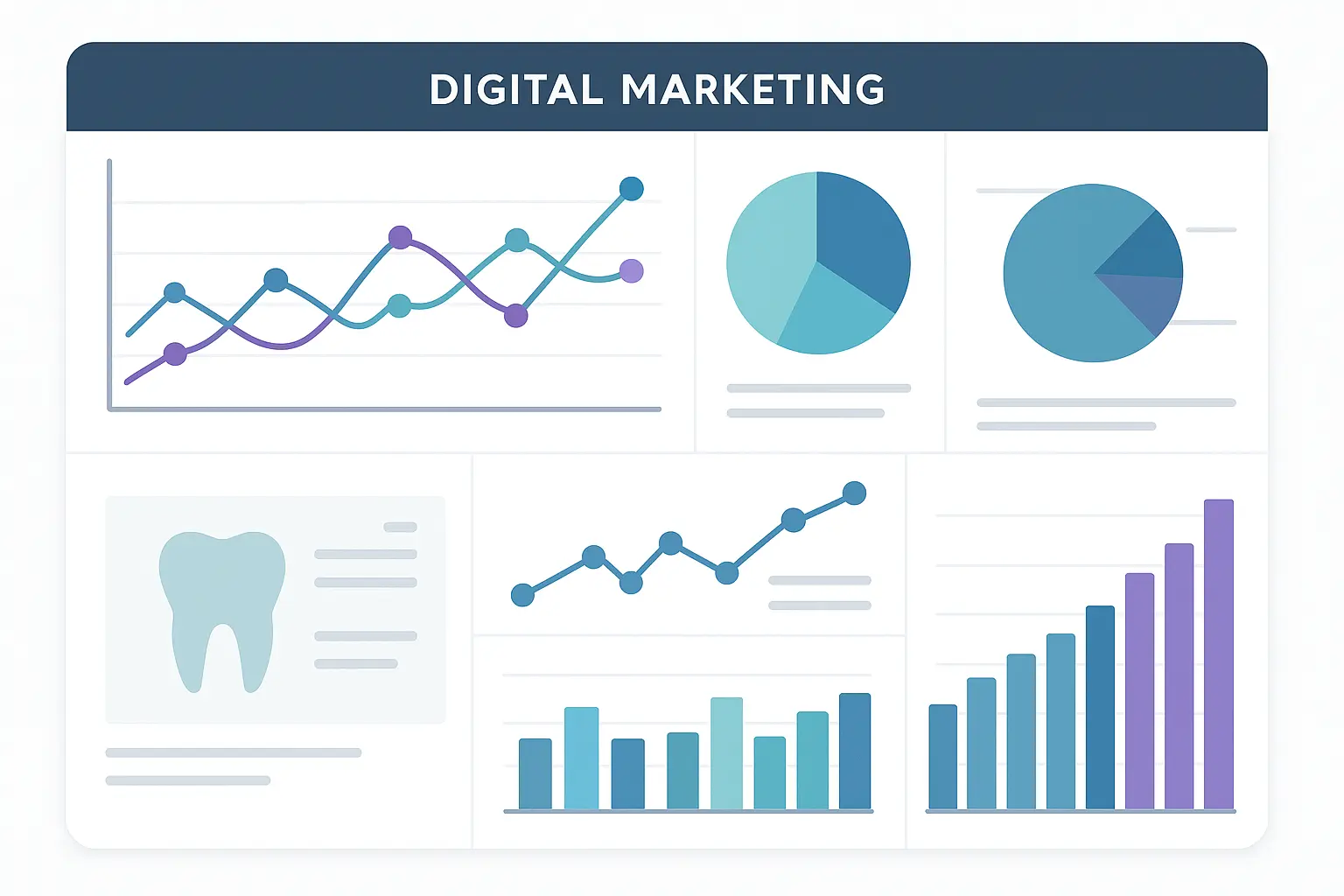
The Stuff That Actually Worked (And Some That Didn’t)
I found 25 dental marketing approaches with real numbers and clear strategies. Some generated massive traffic increases. Others achieved solid returns on ad spend. A few completely changed how practices think about patient relationships. Here’s what I learned, organized by what type of marketing they focused on.
Local Search and SEO Wins
1. Multi-Location Practice Goes All-In on Local SEO
A 12-location dental practice tripled their organic website traffic and nearly doubled new patient bookings over 18 months through local SEO optimization and content marketing.
They started with a mess – inconsistent information across locations and terrible local search visibility. The fix was systematic: location-specific pages for each office, optimized Google My Business profiles, and content that addressed what people in each area actually searched for.
What made it work was consistency. Same business information everywhere online, location-specific content that felt local (not generic), and technical improvements that made their website 60% faster.
2. Small Practice Dominates Local Search
An independent family dentist in suburban Chicago went from page 3 to the top 3 results for 15 key local searches. Phone calls increased by 250% and online bookings doubled.
This practice went all-in on local signals. They got 50+ patient reviews through systematic follow-up, created separate pages for each service optimized for local keywords, and got listed in 25+ dental directories.
The breakthrough came from understanding that local search isn’t just about keywords – it’s about proving you’re actually part of the community. They partnered with local businesses, sponsored community events, and created content about local health concerns.
3. Orthodontist Owns the “Invisalign” Search
An orthodontic practice achieved first-page rankings for “Invisalign” and related keywords in a competitive market, going from 12 new consultations per month to 85.
They built what SEO people call “topical authority” by creating content that answered every question potential patients might have. From “Am I too old for braces?” to detailed cost comparisons between different treatments.
The practice also used before/after photos (with permission) to create visual content that ranked well when people searched for treatment examples. This visual approach drove significant traffic from patients researching their options.
4. Getting Ready for Voice Search
A forward-thinking dental practice optimized for voice search queries and captured 40% more “dentist near me” traffic, positioning themselves ahead of competitors.
Voice search required thinking differently about content. Instead of targeting keywords like “dental implants Chicago,” they optimized for how people actually talk: “where can I get dental implants near me?” and “what’s the best dentist for tooth implants?”
They created FAQ sections that answered questions in natural language, optimized for featured snippets, and made sure their Google My Business information was complete for voice assistant responses.
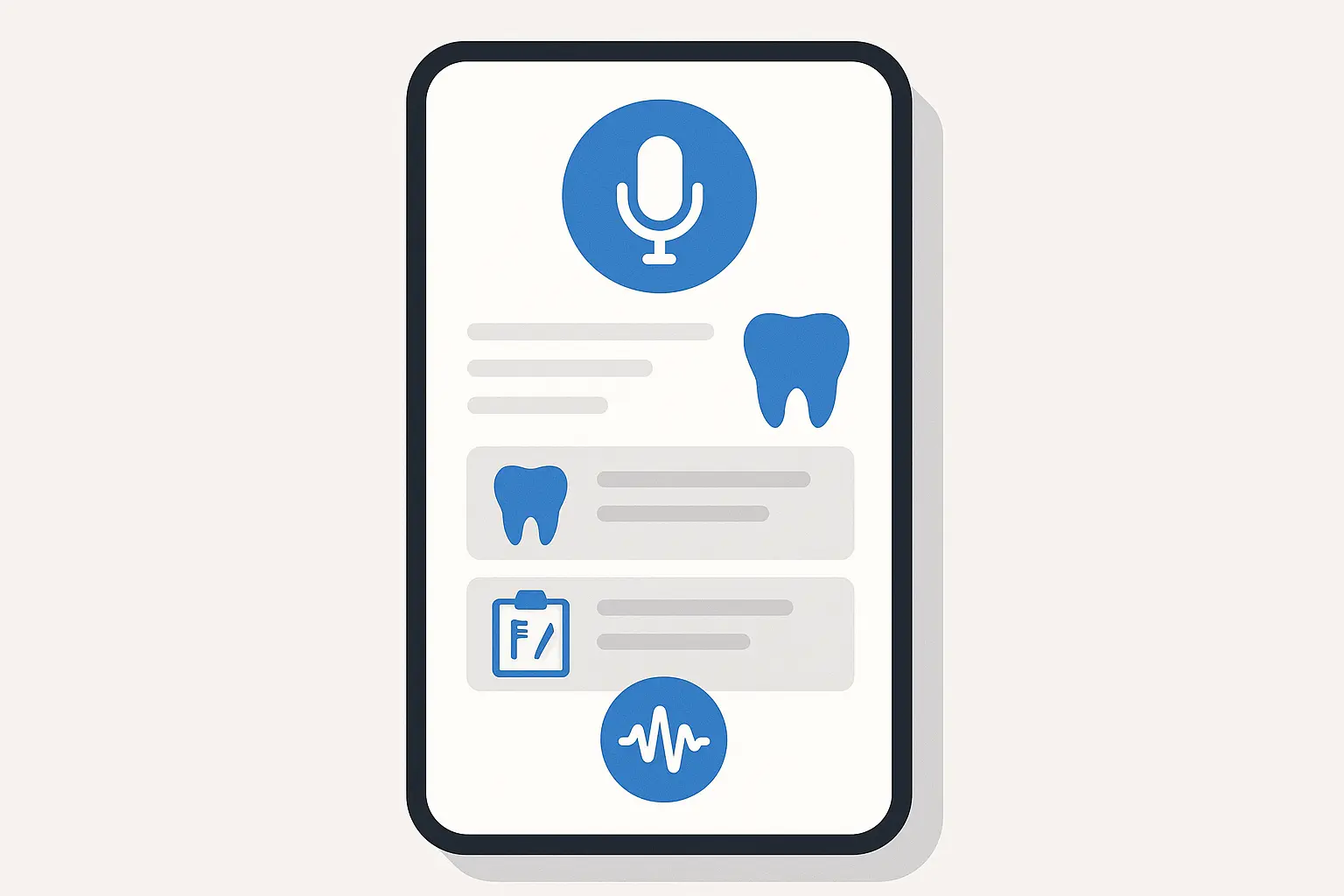
Ads That Actually Made Money
5. Emergency Dental Ads Hit 4:1 ROI
A 24-hour dental clinic made $4 for every $1 spent on Google Ads by targeting emergency dental keywords. They generated $120,000 in revenue from a $30,000 ad spend over 6 months.
Emergency dental searches work because people need help immediately and aren’t shopping around for the cheapest option. The practice created separate landing pages for different emergencies: severe pain, broken teeth, dental trauma, and weekend emergencies.
Their success came from understanding patient psychology during emergencies. Ad copy emphasized immediate availability and pain relief. Landing pages included clear contact information, directions, and what to expect during emergency visits.
6. Facebook Ads for Cosmetic Dentistry
A cosmetic dental practice used targeted Facebook advertising to generate 200 consultation bookings for teeth whitening and veneers, achieving a cost per patient of $85 compared to the industry average of $200.
Facebook’s targeting let them reach people interested in cosmetic procedures, beauty treatments, and smile makeovers. They used video ads with before/after transformations and patient testimonials.
The key was creating separate campaigns for different services. Teeth whitening ads focused on quick results and affordability, while veneer campaigns emphasized dramatic transformations.
7. YouTube Education Drives Implant Consultations
A dental implant specialist used educational YouTube video ads to generate 150 qualified leads in 4 months, with 35% of consultations converting to treatment.
YouTube worked because implant patients need extensive education before deciding. The practice created videos addressing common concerns: procedure steps, recovery time, costs, and success rates.
Their video ads didn’t sell directly. Instead, they offered free consultations and educational resources. This attracted patients serious about treatment rather than just price shopping.
8. Bringing Back Website Visitors
A general dental practice used remarketing campaigns across Google and Facebook to re-engage website visitors, achieving a 45% increase in appointment bookings from previous site visitors.
Remarketing works because most dental website visitors don’t book appointments on their first visit. The practice created different remarketing lists based on pages visited: general services, cosmetic procedures, emergency care, and contact page visitors.
Each audience got tailored messaging. People who viewed cosmetic pages saw ads highlighting smile transformations, while emergency page visitors received ads emphasizing quick availability and pain relief.
How they segmented their remarketing:
A dental practice noticed that website visitors rarely booked on their first visit, so they got smarter about following up. People who looked at general dentistry pages got ads about comprehensive family care. Those who browsed cosmetic procedures saw before/after smile transformations. Emergency page visitors got ads about 24/7 availability. Contact page visitors who didn’t convert received special offers. This targeted approach increased conversions by 45% compared to generic “come back” ads.
9. Seasonal Campaign Optimization
A family dental practice optimized their ads around back-to-school seasons and insurance benefit periods, achieving 60% lower costs per click and 180% higher conversion rates during peak periods.
They identified patterns in patient behavior: families scheduling cleanings before school starts, adults using insurance benefits before year-end, and increased cosmetic interest before holidays.
Campaign optimization included adjusting budgets during peak periods, creating seasonal ad copy and landing pages, and pausing underperforming campaigns during slow periods to focus budget on high-converting opportunities.
Content That Patients Actually Care About
10. Becoming the Go-To Resource
A periodontal practice became the local authority on gum disease through consistent, high-quality blog content, resulting in tripled organic traffic and establishing the dentist as a media expert.
They published comprehensive guides covering every aspect of gum disease: causes, symptoms, treatments, prevention, and recovery. Content addressed patient concerns at every stage of the treatment journey.
The practice gained credibility by citing research, including detailed procedure explanations, and addressing common misconceptions. Local media started contacting them for expert commentary on oral health topics.
Their content strategy success demonstrates the principles we outline in our guide to creating high-impact blog topics that establish authority and drive meaningful engagement.
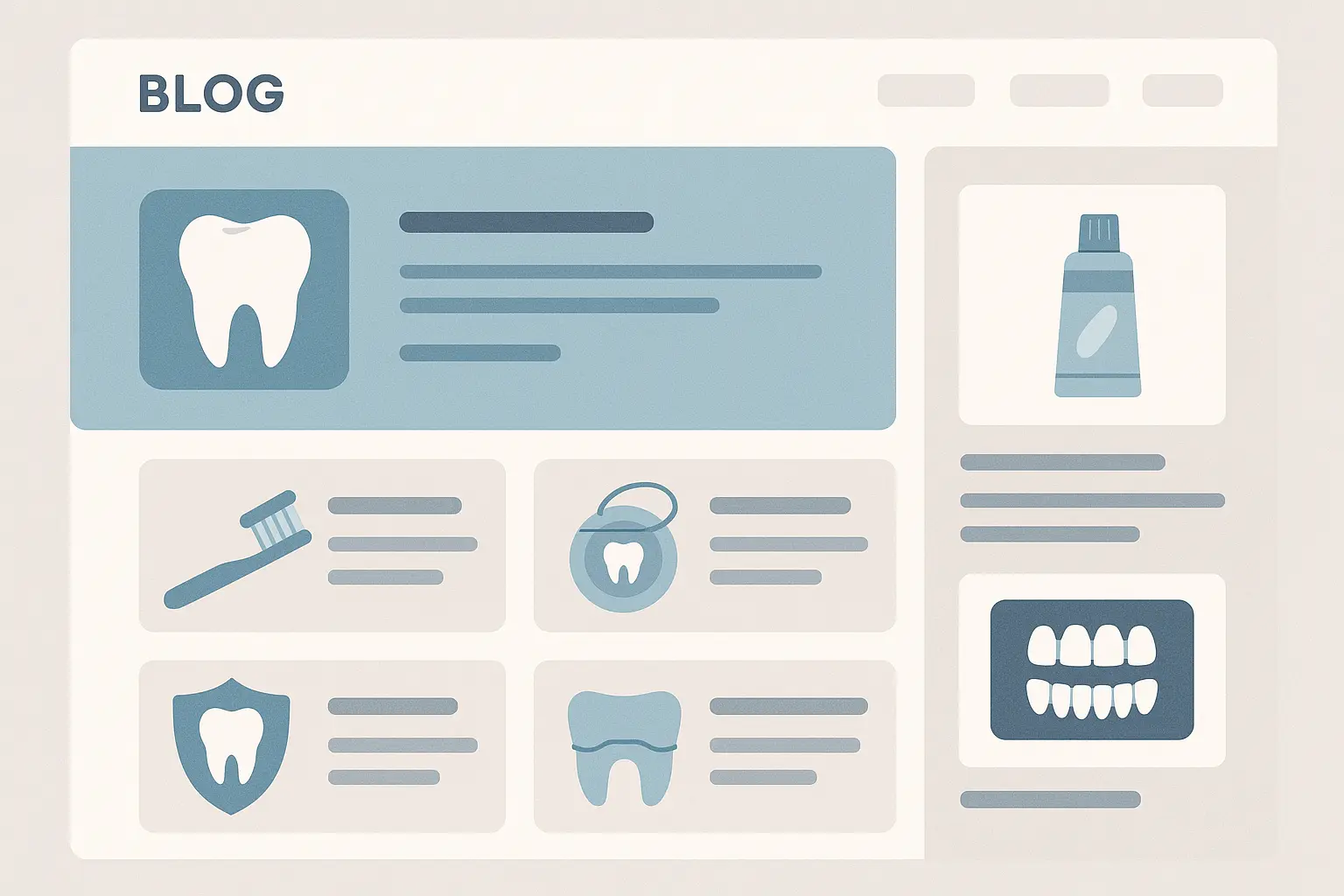
11. Video Content That Kids (And Parents) Love
A pediatric dental practice created educational videos for children and parents, achieving 2 million views across platforms and increasing new patient appointments by 220%.
Their videos made dental care less scary for kids. They created animated explanations of procedures, tours of their kid-friendly office, and videos showing children having positive experiences.
Parent-focused videos addressed common concerns: when to start dental visits, handling dental anxiety, and what to expect during procedures. This educational approach built trust before families ever visited.
12. Podcast Marketing (Yes, Really)
A dental practice launched a weekly health podcast featuring the dentist, generating 10,000+ monthly downloads and attracting high-value patients interested in comprehensive care.
The podcast covered connections between oral health and overall wellness, interviewed other healthcare professionals, and discussed lifestyle factors affecting dental health. This positioned the dentist as a holistic healthcare provider.
Podcast listeners became highly engaged patients who valued comprehensive care and were less price-sensitive. Many became advocates who referred friends and family.
13. Interactive Tools That Actually Help
A cosmetic dentist created interactive smile assessment tools and virtual consultations, increasing website engagement time by 400% and consultation booking rates by 150%.
Interactive tools included smile quizzes, treatment cost calculators, and virtual consultation scheduling. Patients could upload photos for preliminary assessments and receive personalized recommendations.
This approach qualified leads before consultations, ensuring in-person appointments were with serious treatment candidates. It also provided valuable data about patient preferences and concerns.
Social Media That Doesn’t Suck
14. Instagram Storytelling
A cosmetic dental practice built 50,000+ engaged followers through before/after transformations and behind-the-scenes content, generating 30+ new patients monthly from Instagram alone.
Their strategy focused on visual storytelling rather than direct promotion. They shared patient transformation stories (with permission), behind-the-scenes office content, and educational posts about cosmetic procedures.
Consistent posting, professional photography, and authentic patient stories created an engaged community. They used Instagram Stories for real-time content and polls to increase engagement.
15. TikTok for Younger Patients
A young dentist used TikTok’s algorithm with educational content, reaching 5 million views and attracting younger patients who traditionally avoided dental care.
TikTok content included quick dental tips, myth-busting videos, and behind-the-scenes procedure looks. The informal, educational approach made dental care seem more approachable to younger audiences.
The practice saw significant increases in appointments from patients aged 18-35, a demographic that historically avoided regular dental care. Many cited the TikTok videos as their introduction to the practice.
16. Facebook Community Building
A family dental practice created a private Facebook group focused on family oral health, building a community of 3,000+ engaged parents and generating consistent referrals.
The group provided space for parents to ask questions about children’s dental health, share experiences, and receive advice from the dental team. Regular live Q&A sessions increased engagement and built relationships.
Group members became practice advocates, referring friends and family. The community also provided valuable insights into patient concerns that informed other marketing efforts.
17. LinkedIn for Business Networking
A dental practice owner used LinkedIn to connect with local businesses, securing corporate dental plans and executive patients worth $200,000+ annually.
LinkedIn strategy focused on building relationships with local business owners, HR professionals, and executives. The dentist shared content about workplace wellness, stress-related dental issues, and executive health.
These connections led to corporate partnerships, executive patient referrals, and speaking opportunities at business events. The practice became the preferred provider for several local companies.
18. Handling Online Reputation Crises
A dental practice successfully managed a negative online reputation crisis through strategic social media response and proactive community engagement, recovering their 5-star rating within 3 months.
When faced with negative reviews and social media criticism, the practice responded professionally and transparently. They addressed legitimate concerns, corrected misinformation, and demonstrated their commitment to patient care.
Proactive engagement included sharing patient success stories, highlighting staff expertise, and showcasing community involvement. This positive content gradually overshadowed negative publicity and restored their reputation.

Email That People Actually Read
19. Welcome Email Series That Works
A general dental practice set up a 12-email welcome sequence for new patients, increasing treatment acceptance rates by 65% and adding $1,200 per patient in lifetime value.
The email sequence educated new patients about preventive care, introduced the dental team, explained office policies, and provided oral health tips. Each email built trust and demonstrated the practice’s commitment to patient care.
Automated sequences meant consistent communication without requiring staff time. Patients who went through the sequence were more likely to accept treatment recommendations and keep regular appointments.
20. Fixing the Recall System
A dental practice redesigned their recall email system with personalized content and scheduling links, improving recall appointment compliance by 85% and reducing no-shows by 40%.
Traditional recall postcards were replaced with personalized emails including patient names, last visit dates, and recommended treatments. One-click scheduling links made booking effortless.
Email content was tailored based on patient history. Patients with previous cosmetic work received different messaging than those focused on preventive care.
|
Email Strategy |
Setup Time |
What You Need |
Results You Can Expect |
|---|---|---|---|
|
Welcome sequence (12 emails) |
2-3 weeks |
Email automation platform, content |
65% better treatment acceptance |
|
Recall system upgrade |
1-2 weeks |
Email platform that connects to your practice software |
85% better recall compliance |
|
Reactivation campaigns |
1 week |
Patient lists, special offers |
Potentially $180,000+ additional revenue |
|
Post-treatment follow-up |
3-4 weeks |
Automated workflows, care instructions |
30% fewer complications |
21. Post-Treatment Follow-Up
An oral surgery practice implemented post-treatment email sequences with care instructions and check-ins, reducing complications by 30% and increasing patient satisfaction scores to 9.8/10.
Follow-up emails provided detailed post-operative instructions, answered common questions, and offered direct contact for concerns. Patients felt supported throughout recovery.
Systematic follow-up reduced emergency calls, improved healing outcomes, and increased satisfaction. Many patients referred friends and family based on their positive experience.
22. Bringing Back Lost Patients
A dental practice reactivated 400+ dormant patients through targeted email campaigns offering special promotions and highlighting new services, generating $180,000 in additional revenue.
The reactivation campaign segmented dormant patients by last visit date and treatment history. Patients absent 1-2 years received different messaging than those gone 3+ years.
Email content addressed common reasons for avoiding dental care: cost concerns, anxiety, and scheduling difficulties. The practice offered payment options, sedation dentistry, and extended hours to remove barriers.
How they segmented their comeback campaign:
A practice had 1,200 patients who’d basically disappeared, so they got strategic about winning them back. Recent lapsers (6-18 months gone) got gentle “we miss you” messages about preventive care. Long-term dormant patients (2-4 years) received education-focused emails about new technologies and services. Very long-term patients (4+ years) got special comeback offers with significant discounts. The segmented approach got 32% of people to return compared to 8% for generic “come back” emails.
When Everything Works Together
23. Creating a Seamless Patient Experience
A multi-specialty dental practice created a consistent patient journey across all touchpoints, increasing conversion rates by 75% and patient satisfaction by 40% through unified messaging and experience.
Every interaction – website, social media, email, phone calls – delivered consistent messaging about the practice’s values, services, and patient care philosophy. Patients experienced the same professionalism regardless of how they contacted the practice.
The integrated approach included synchronized content calendars, unified visual branding, and coordinated promotional campaigns. Patient data was centralized to provide personalized experiences at every touchpoint.
24. Marketing Automation That Actually Helps
A growing dental practice implemented comprehensive marketing automation connecting their website, CRM, email marketing, and social media, reducing manual work by 60% while increasing lead quality by 90%.
Automation workflows triggered based on patient behavior: website visitors received follow-up emails, consultation requests generated automatic confirmations, and treatment completions triggered review requests.
The system scored leads based on engagement levels, treatment interest, and demographics. High-scoring leads got immediate attention from the team, while lower-scoring leads entered nurturing sequences.

25. Data-Driven Everything
A dental practice used advanced analytics and patient data to optimize their entire marketing approach, achieving a 300% improvement in marketing ROI and reducing patient acquisition costs by 45%.
Comprehensive tracking revealed which marketing channels generated the highest-value patients, which content drove the most conversions, and which patient segments were most profitable.
Data insights informed budget allocation, content creation priorities, and campaign optimization. The practice continuously tested and refined their approach based on performance rather than assumptions.
Their success mirrors the analytical framework detailed in our comprehensive GA4 audit guide, which provides the foundation for data-driven marketing decisions.
Simple Stuff You Can Start Tomorrow vs Complex Strategies That Take Months
The complexity varies dramatically across these approaches. Simple things like local search optimization and Facebook community building need minimal resources but deliver solid results. Complex strategies involving marketing automation and data integration require significant investment but can transform how your practice operates.
Simple Stuff You Can Start Tomorrow
Local Search Optimization (from Case Study 2)
Start with your Google My Business profile. Make sure your practice name, address, and phone number are identical everywhere online. Upload good photos of your office, team, and equipment.
Create a simple process for getting patient reviews. Send follow-up emails after appointments with direct links to your Google review page. Respond professionally to all reviews, good and bad.
Get listed in dental directories and local business listings. Focus on consistency – same information everywhere.
Facebook Community Building (from Case Study 16)
Create a private Facebook group about oral health for families. Post daily tips about kids’ dental care, answer common questions, and share relevant health articles.
Host monthly live Q&A sessions where parents can ask questions directly. This builds relationships and positions your practice as a trusted resource.
Encourage group members to share positive experiences (without violating privacy) and refer friends who might benefit from joining.
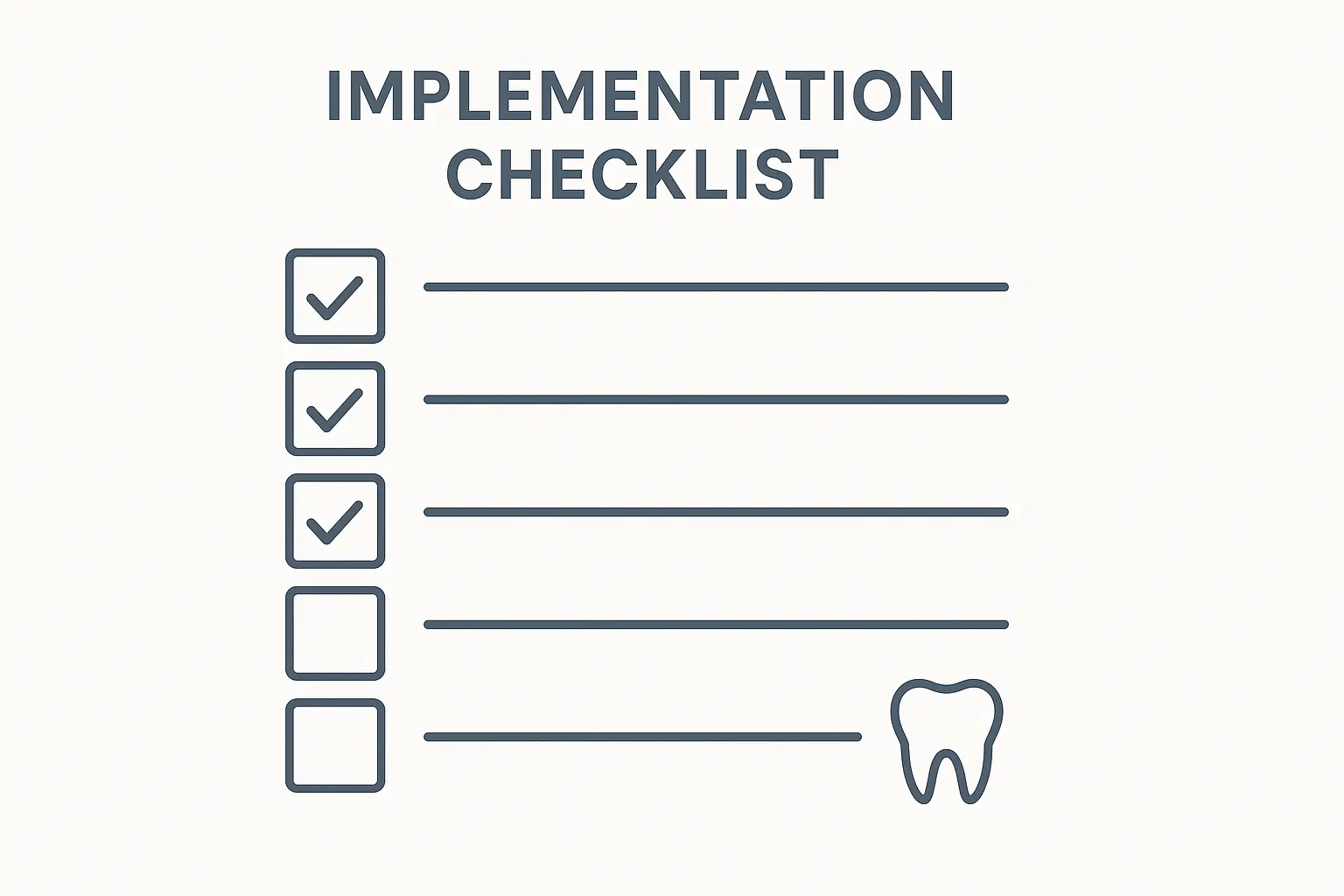
Complex Strategies for Serious Growth
Data-Driven Marketing Optimization (from Case Study 25)
Phase 1: Setting Up Tracking (Months 1-2)
Implement Google Analytics 4 with enhanced tracking to monitor patient journey from first website visit through treatment completion. Set up conversion tracking for phone calls, form submissions, and appointment bookings.
Connect your practice management system with marketing automation. This lets you track which marketing efforts generate the highest-value patients and longest retention.
Create detailed patient journey maps identifying every touchpoint from initial awareness through treatment completion and referrals.
Phase 2: Connecting Everything (Months 3-4)
Connect website forms to automated email sequences that nurture leads based on interests and engagement. Set up remarketing campaigns that show relevant ads based on services viewed.
Synchronize audiences across channels so patients who engage on one platform receive coordinated messaging everywhere.
Develop lead scoring models that identify which prospects are most likely to book appointments and accept treatments.
Phase 3: Optimization and Scaling (Months 5-12)
A/B test landing pages for each service, measuring not just conversion rates but patient lifetime value and treatment acceptance.
Optimize ad spending based on actual patient value rather than just cost per click. High-value treatments like implants justify higher acquisition costs.
Implement dynamic content that shows different website content based on visitor behavior, location, and referral source.
How This Stacks Up Against Real-World Budgets and Time
Looking at these 25 approaches against practical criteria reveals clear winners in different categories. The best ROI comes from emergency dental ads and email automation. The most scalable are local SEO and remarketing campaigns. Data-driven approaches consistently beat gut-feeling strategies, while current solutions address how patients actually behave today.
|
Type of Marketing |
Best ROI Examples |
How Well It Scales |
What You Need |
How Long It Takes |
|---|---|---|---|---|
|
Local SEO |
Cases 1, 2, 4 |
Works for any practice size |
Low to medium budget |
3-6 months |
|
Paid Ads |
Cases 5, 9 |
Depends on your budget |
Medium to high budget |
1-3 months |
|
Content Marketing |
Cases 10, 11 |
Scales with effort |
Medium budget |
6-12 months |
|
Social Media |
Cases 14, 15, 16 |
Depends on platform |
Low to medium budget |
2-6 months |
|
Email Marketing |
Cases 19, 22 |
Scales really well |
Low budget |
2-4 weeks |
|
Integrated Approaches |
Cases 23, 24, 25 |
Scales very well |
High budget |
6-18 months |
ROI Champions That Actually Pay for Themselves
Emergency dental ads (Case Study 5) lead with 4:1 returns because emergency patients need help immediately and aren’t price shopping. The clear revenue connection makes this easy to justify and scale.
Email automation (Case Study 19) generates $1, 200+ additional lifetime value per patient through systematic nurturing and education. Since it’s automated, results compound without proportional increases in effort or cost.
Data-driven optimization (Case Study 25) achieves 300% ROI improvement by eliminating wasteful spending and focusing resources on highest-performing channels and patient segments.
What Scales Across Different Practice Sizes
Multi-location SEO (Case Study 1) proves that local search strategies work regardless of practice size. Single-location practices can use the same principles with smaller resource requirements.
Remarketing campaigns (Case Study 8) scale efficiently because they target people who already showed interest. Small practices can start with basic remarketing while larger practices can implement sophisticated audience segmentation.
Content marketing approaches (Cases 10-13) scale based on content creation capacity rather than advertising budget. Practices can start with simple blog posts and expand to video and interactive tools as resources allow.
Data vs Gut Feelings
Case studies emphasizing systematic testing and optimization (Cases 9, 25) consistently outperform those relying on creative hunches or industry best practices.
Seasonal ad optimization (Case Study 9) succeeded because it was based on actual patient behavior patterns rather than assumptions about when people seek dental care.
Voice search optimization (Case Study 4) worked because the practice analyzed search query data rather than guessing how people would use voice assistants.
What Works Today vs Yesterday’s Tactics
TikTok dental education (Case Study 15) addresses the reality that younger patients consume information differently than previous generations. Practices ignoring this shift miss opportunities to connect with emerging demographics.
Interactive content engagement (Case Study 13) meets modern patient expectations for personalized, on-demand information. Patients increasingly expect to research and evaluate options before booking appointments.
Marketing automation integration (Case Study 24) acknowledges that patients interact with practices across multiple channels and expect consistent, coordinated experiences.
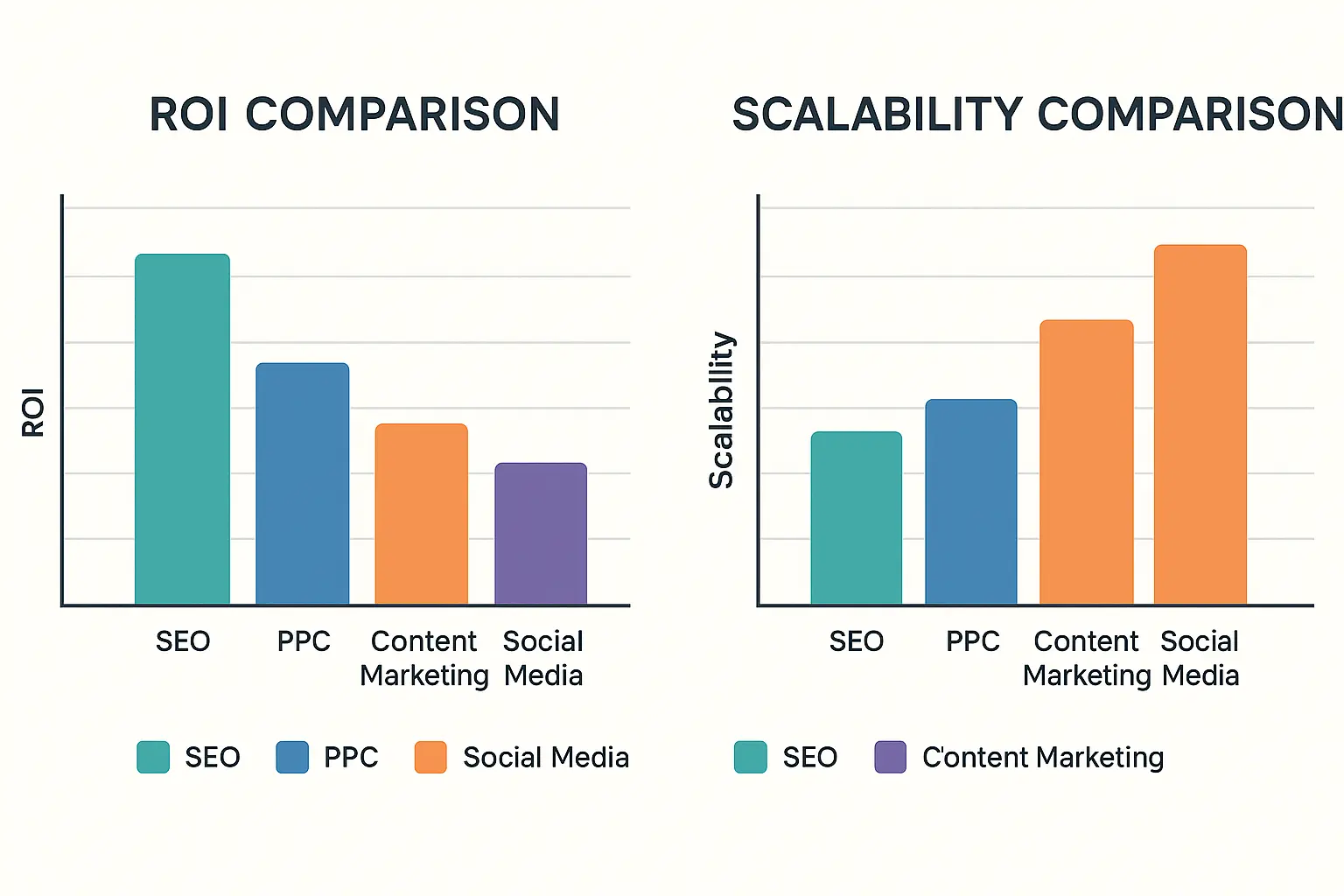
Why Most Agencies Miss the Obvious Stuff
Most dental marketing agencies focus on vanity metrics and single-channel tactics rather than the integrated, performance-focused approaches demonstrated in these successful case studies. The Marketing Agency’s scientific methodology and comprehensive service integration directly address the gaps that cause other agencies to deliver disappointing results for dental practices.
The disconnect between what these case studies reveal and what most agencies deliver comes down to fundamental differences in approach and expertise.
Vanity Metrics vs Real Business Results
Most agencies celebrate increases in website traffic, social media followers, or email open rates. The successful case studies focus on metrics that actually impact practice revenue: patient acquisition costs, lifetime value, treatment acceptance rates, and recall compliance.
The Marketing Agency’s emphasis on ROI and performance aligns with the case studies that generated real business growth rather than impressive-sounding but meaningless statistics.
Single-Channel Focus vs Everything Working Together
The highest-performing case studies (particularly Cases 23-25) demonstrate the power of coordinated multi-channel approaches. Most agencies specialize in one area – SEO, ads, or social media – and miss the synergistic effects of integrated campaigns.
The Marketing Agency’s comprehensive service offering across SEO, PPC, email marketing, and inbound marketing creates the coordinated approach that drives exponential rather than incremental results.
This integrated approach aligns with the methodology outlined in our SEO ROI calculator guide, which demonstrates how multiple channels compound returns when properly coordinated.
Scientific Method vs Creative Guesswork
Case studies achieving sustainable results use systematic testing, data analysis, and continuous optimization. Many agencies rely on creative intuition or outdated best practices rather than scientific methodology.
The Marketing Agency’s “highly tuned scientific approach to market analysis” enables them to identify opportunities and optimize performance based on actual data rather than assumptions.
Flexible Investment vs One-Size-Fits-All
These case studies show that successful dental marketing requires different resource levels at different growth stages. Practices need partners who can scale services appropriately rather than forcing every client into identical packages.
With service costs ranging from $500-$10,000 per month across different channels, The Marketing Agency provides the flexibility to match investment levels with practice goals and growth stages.
The case studies reveal that dental marketing success requires specialized healthcare marketing expertise, comprehensive tracking capabilities, and the ability to execute integrated campaigns across multiple channels. The Marketing Agency’s combination of scientific methodology, performance focus, and scalable service offerings positions them to deliver the results demonstrated in these top-performing case studies.
Understanding the full scope of digital marketing opportunities requires the comprehensive approach detailed in our market sizing guide for business opportunities, which helps practices identify their growth potential.
Ready to implement strategies that actually work? The Marketing Agency can help you identify which of these approaches best fit your practice goals and market situation.

What I Actually Learned From All This
These 25 dental marketing case studies provide a roadmap for practices that want measurable growth rather than marketing theater. The most successful approaches combine data-driven decision making, integrated multi-channel strategies, and systematic optimization based on actual patient behavior rather than industry assumptions.
The dental marketing landscape rewards practices that treat marketing as a measurable business process rather than a creative experiment. These case studies prove that systematic approaches, comprehensive tracking, and patient-focused strategies consistently outperform flashy campaigns that prioritize looks over results.
What strikes me most about these successful implementations is their focus on solving real patient problems rather than promoting services. The practices that achieved 300%+ growth improvements understood their patients’ needs, concerns, and decision-making processes. They created marketing systems that educated, supported, and guided patients rather than advertising at them.
The integration aspect can’t be overstated. Single-channel approaches might generate short-term spikes, but sustainable growth comes from coordinated strategies that reinforce each other across multiple touchpoints. Patients don’t experience your SEO separately from your social media or email marketing – they experience your practice as a unified entity.
For practices ready to move beyond hope-based marketing toward results-driven growth, these case studies provide both inspiration and practical roadmaps. The question isn’t whether these strategies work – the numbers prove they do. The question is whether you’re ready to implement them systematically and measure what matters.
Most of this stuff takes months to show results. If someone promises to double your patients in 30 days, they’re probably lying or about to do something that’ll hurt you long-term. Good marketing is like exercise – consistent, sometimes boring, but it works if you stick with it.



